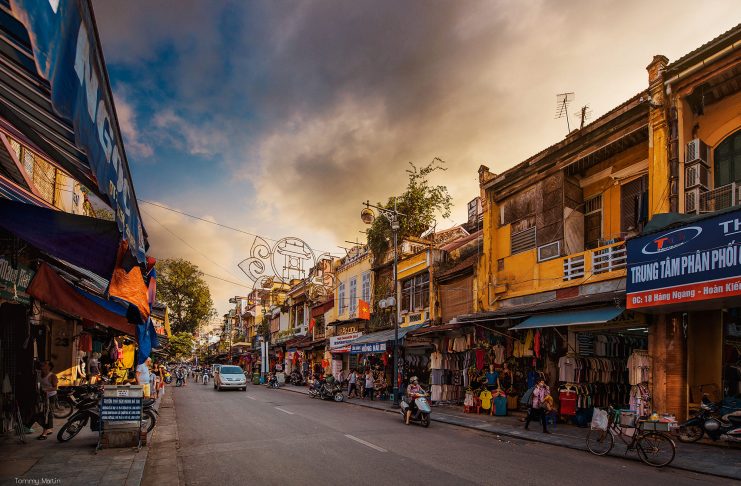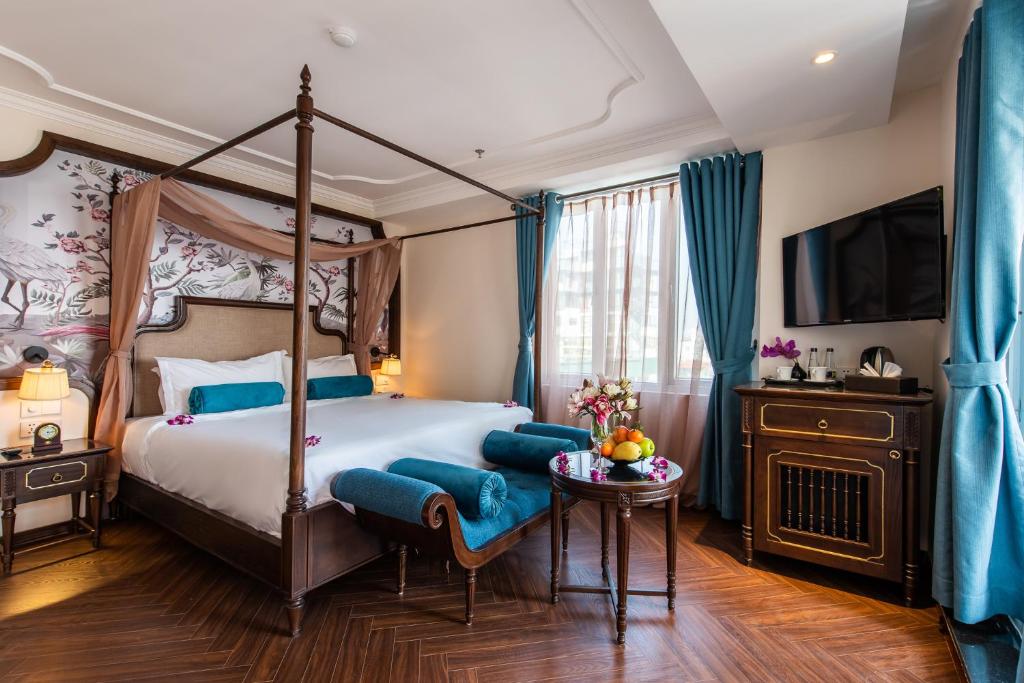What is Old Quarter of Hanoi?

- Hanoi's Old Quarter, also known as "36 Pho Phuong" (36 Streets), is a historic and vibrant district in the heart of Vietnam's capital city. This enchanting neighborhood is a living testament to Hanoi's rich cultural heritage and centuries of history.
- The Old Quarter's labyrinthine network of narrow, meandering streets is lined with well-preserved colonial-era architecture, ancient temples, and traditional shop-houses. Each street was historically associated with a particular craft or trade, and many of these traditional businesses are still thriving today. From silversmiths and tailors to street food vendors and art galleries, the Old Quarter offers a diverse range of experiences.
- Visitors can immerse themselves in Hanoi's bustling street life, sample delectable local street food like pho and banh mi, and browse through colorful markets. The Old Quarter is home to numerous historical sites, such as the Bach Ma Temple and the Ngoc Son Temple situated on the picturesque Hoan Kiem Lake. It's a place where the past seamlessly blends with the present, making it a must-visit destination for travellers seeking an authentic and culturally rich experience in Hanoi.
Places:
- Hanoi's Old Quarter, often referred to as the "36 Streets," derives its name from the historic division of the area into 36 specialized streets, each dedicated to a specific trade or craft. These streets have been the backbone of commerce and culture in the Old Quarter for centuries. While not all of the original trades are still in operation today, many have evolved, and the Old Quarter remains a bustling hub of activity. Here are some of the iconic streets and their associated trades
- Feature of streets:
Hang Bac Street: It is one of 36 longest guild streets in Hanoi. Their reputation is professional on jewellery business. It provides many types of impressive products for loving jewellery people. Coincidently, this is same with its name that it used to be huge point of producing silver during ancient time. Under 15th century, the bureaucracy determined changing silver industry to Hanoi where silver industry was bloomed. From that time to now, because of having huge reputation that the name of Hang Bac street was born. From Hang Bac street, there are many places to go such as Bia Street, Ma May Street, Dinh Liet Street, Gia Ngu Street where you can figure out some kind of food and services if it is possible to you. Hang Bac Street is where to hook you up with some colourful streets in Hanoi.
Hang Ma street: Hang Ma street is a part of Hoan Kiem district.
- Festival decoration: Hang Ma Street is most beautiful during festivals, particularly Tet. During this time, the street is adorned with colourful and intricate decorations, such as lanterns, paper flowers, traditional masks, and other festive items. The vibrant colours and designs create a lively and joyous atmosphere.
- Cultural Heritage: The street has a rich cultural history, dating back to the ancient times. It has been a hub for traditional crafts and artisanal products, preserving Vietnam's cultural heritage and traditions.
- Historical Significance: The street has historical significance as it has been associated with trade and commerce for centuries, and its name, Hang Ma, means "Paper Street," reflecting its historical role as a centre for paper and craft supplies.
- Authentic Experience: Hang Ma Street offers an authentic taste of Vietnamese culture and traditions. It's a place where you can experience the local way of life and interact with friendly locals.
Lan Ong Street, in Hanoi, Vietnam, is a culturally rich and historically significant destination known as "Hanoi's Old Medicine Street." Its beauty lies in the preservation of traditional medicine practices, its historical charm, and the authentic cultural experience it offers. The street's traditional medicine shops and herbal stores, coupled with its connection to the 18th-century physician Le Huu Trac, provide a unique glimpse into traditional Vietnamese healing. While lacking grand architectural landmarks, Lan Ong Street's well-preserved French colonial-style buildings and traditional shophouses exude an old-world charm. It offers an authentic atmosphere and the opportunity to explore age-old remedies and purchase distinctive souvenirs. In summary, Lan Ong Street's beauty is a combination of its cultural significance, historical roots, architectural character, and the authenticity of its traditional medicine heritage. It's a place where the beauty is woven into the tapestry of tradition and history.
O Quan Chuong is a gate of ancient Hanoi, located on the east side of the land citadel surrounding Thang Long Citadel. This is one of the 21 remaining gates of the old Thang Long citadel, a relic that was classified in 1995. Architecturally, there is a dome guarding the gate, and on top there is also a guard house. The gate was built with a wide arch. Previously, there were two large thick wooden gates. At night, guards closed the gate and opened it in the morning for people to travel and trade. People call this doorway the Quan Chuong doorway to remember the merits and sacrifices of the Chancellor - commander of the guards, from Bac Ninh, who together with about 100 Nguyen Dynasty soldiers heroically fought against the enemy. French troops when they attacked Hanoi citadel for the first time (1873) through Dong Ha gate. The upper floor has a 4-roof gazebo, miniature right above the roof of the main door, surrounded by railings decorated with hexagons, quadrilaterals, and rosettes. In the past, patrolmen often stood on gazebos to observe their surroundings. Between the top of the main door and the gazebo is a rectangular frame (nearly 1m high, about 3m wide), on the front there are three Chinese characters embossed in blue porcelain: "Dong Ha Mon".
Ma May Street is a historic and culturally rich gem in the heart of Hanoi, Vietnam, known for its old-world charm and vibrant atmosphere. As a popular tourist destination, Ma May Street offers a unique blend of traditional and modern experiences. Visitors can explore traditional shophouses, sample authentic Vietnamese cuisine, and shop for souvenirs while immersing themselves in the local culture. Its proximity to popular landmarks, such as the Old Quarter and Hoan Kiem Lake, makes it an ideal base for tourists. Whether you're interested in history, food, or shopping, Ma May Street has something for everyone, making it a must-visit location in Hanoi.
Hotels & Services:
- Hanoi's Old Quarter does offer a wide range of hotels and accommodation options that cater to various budgets and preferences. Whether you're looking for budget-friendly hostels, mid-range hotels, boutique accommodations, or luxury hotels, you'll likely find suitable places to stay in this historic part of the city.

Cuisine & Nightlife:

- Food Variety:
Street Food: The Old Quarter is a street food paradise. You'll find countless food stalls and vendors offering a wide range of Vietnamese dishes. Be sure to try local specialties like pho (noodle soup), bun cha (grilled pork with noodles), banh mi (Vietnamese sandwich), and fresh spring rolls. The variety is extensive, and you can explore different flavors on almost every street.
Local Restaurants: In addition to street food, the Old Quarter has many local restaurants and eateries serving authentic Vietnamese cuisine. These restaurants provide a sit-down dining experience and often offer a more extensive menu.
- International Cuisine:
The Old Quarter caters to a diverse range of tastes, so you can also find international restaurants, including French, Italian, Japanese, and more.
- Night Markets:
Some streets come alive with night markets in the evenings, offering not only a wide array of street food but also clothes, souvenirs, and other items for sale.
- Nightlife:
Bars and Pubs: The Old Quarter has numerous bars and pubs where you can enjoy a range of beverages, from Vietnamese beers to cocktails. Some bars have live music and DJ sets, creating a lively atmosphere.
Clubs and Nightclubs: If you're into dancing and partying, there are nightclubs in the Old Quarter that stay open late into the night, playing a mix of music genres.
Rooftop Bars: Several hotels in the area have rooftop bars with great views of the city, making them ideal for a more relaxed and scenic night out.
Cultural Performances: Some venues in the Old Quarter host traditional Vietnamese music and dance performances, providing a more cultural and artistic evening option.
Late-Night Street Food: The streets of the Old Quarter stay busy late into the night, and you can continue to enjoy street food and snacks during your nighttime adventures.
